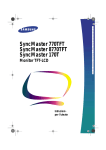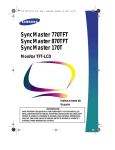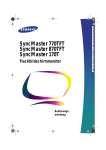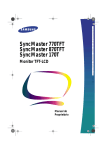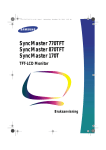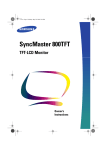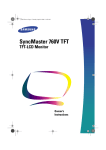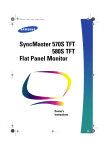Download Samsung 870TFT Specifications
Transcript
Page 1 Wednesday, December 20, 2000 TFT-LCD Monitor 1 S/M 870/770/170 co.fm SyncMaster 770TFT SyncMaster 870TFT SyncMaster 170T 1:54 PM Owner’s Instructions 1 S/M 870/770/170 co.fm Page 2 Wednesday, December 20, 2000 1:55 PM Information in this document is subject to change without notice. © 2000 Samsung Electronics Co., Ltd. All rights reserved. Reproduction in any manner whatsoever without the written permission of Samsung Electronics Co., Ltd. is strictly forbidden. Samsung Electronics Co., Ltd. shall not be liable for errors contained herein or for incidental or consequential damages in connection with the furnishing, performance, or use of this material. The Samsung logo and SyncMaster are registered trademarks of Samsung Electronics Co., Ltd.; Microsoft, Windows ® and Windows® NT are registered trademarks of Microsoft Corporation; VESA, DPMS and DDC are registered trademarks of Video Electronics Standard Association; the ENERGY STAR name and logo are registered trademarks of the U.S. Environmental Protection Agency (EPA). As an ENERGY STAR Partner, Samsung Electronics Co., Ltd. has determined that this product meets the ENERGY STAR guidelines for energy efficiency. All other product names mentioned herein may be the trademarks or registered trademarks of their respective owners. English 1 Français Safety Instructions . . . . . . . . . . . . . . . . . . . . . . . . . . . . . . . . . . . . . . . . . . . . . . . . . . . . . . . . . . 2 Unpacking Your LCD Monitor . . . . . . . . . . . . . . . . . . . . . . . . . . . . . . . . . . . . . . . . . . . . . . . . . . 3 Setting up Your LCD Monitor . . . . . . . . . . . . . . . . . . . . . . . . . . . . . . . . . . . . . . . . . . . . . . . . . . 4 Setting up an Ergonomic Workstation . . . . . . . . . . . . . . . . . . . . . . . . . . . . . . . . . . . . . . . . 4 Monitor location . . . . . . . . . . . . . . . . . . . . . . . . . . . . . . . . . . . . . . . . . . . . . . . . . . . . . . 4 Workstation height . . . . . . . . . . . . . . . . . . . . . . . . . . . . . . . . . . . . . . . . . . . . . . . . . . . 4 Viewing angle . . . . . . . . . . . . . . . . . . . . . . . . . . . . . . . . . . . . . . . . . . . . . . . . . . . . . . . 4 Kensington Security Slot . . . . . . . . . . . . . . . . . . . . . . . . . . . . . . . . . . . . . . . . . . . . . . . . . . 4 Connecting Your LCD Monitor. . . . . . . . . . . . . . . . . . . . . . . . . . . . . . . . . . . . . . . . . . . . . . . 5 Getting Help . . . . . . . . . . . . . . . . . . . . . . . . . . . . . . . . . . . . . . . . . . . . . . . . . . . . . . . . . . . . 7 Plug and Play . . . . . . . . . . . . . . . . . . . . . . . . . . . . . . . . . . . . . . . . . . . . . . . . . . . . . . . . . . . 7 Auto Adjustment . . . . . . . . . . . . . . . . . . . . . . . . . . . . . . . . . . . . . . . . . . . . . . . . . . . . . . . . 7 Installing the Video Driver. . . . . . . . . . . . . . . . . . . . . . . . . . . . . . . . . . . . . . . . . . . . . . . . . . 7 Windows® 98 . . . . . . . . . . . . . . . . . . . . . . . . . . . . . . . . . . . . . . . . . . . . . . . . . . . . . . . . 8 Windows® 95 . . . . . . . . . . . . . . . . . . . . . . . . . . . . . . . . . . . . . . . . . . . . . . . . . . . . . . . . 8 Self-Test Feature Check (STFC) . . . . . . . . . . . . . . . . . . . . . . . . . . . . . . . . . . . . . . . . . . . . . 9 Adjusting Your LCD Monitor . . . . . . . . . . . . . . . . . . . . . . . . . . . . . . . . . . . . . . . . . . . . . . . . . . 10 User Controls . . . . . . . . . . . . . . . . . . . . . . . . . . . . . . . . . . . . . . . . . . . . . . . . . . . . . . . . . . 10 Automatic Save . . . . . . . . . . . . . . . . . . . . . . . . . . . . . . . . . . . . . . . . . . . . . . . . . . . . . . . . 11 Direct-Access Features . . . . . . . . . . . . . . . . . . . . . . . . . . . . . . . . . . . . . . . . . . . . . . . . . . 11 Brightness . . . . . . . . . . . . . . . . . . . . . . . . . . . . . . . . . . . . . . . . . . . . . . . . . . . . . . . . . . 11 Auto Adjustment . . . . . . . . . . . . . . . . . . . . . . . . . . . . . . . . . . . . . . . . . . . . . . . . . . . . . 12 OSD Lock/Unlock . . . . . . . . . . . . . . . . . . . . . . . . . . . . . . . . . . . . . . . . . . . . . . . . . . . . 12 On Screen Display (OSD) . . . . . . . . . . . . . . . . . . . . . . . . . . . . . . . . . . . . . . . . . . . . . . . . . 13 Accessing the Menu System . . . . . . . . . . . . . . . . . . . . . . . . . . . . . . . . . . . . . . . . . . . 13 Appendix . . . . . . . . . . . . . . . . . . . . . . . . . . . . . . . . . . . . . . . . . . . . . . . . . . . . . . . . . . . . . . . . . 17 PowerSaver . . . . . . . . . . . . . . . . . . . . . . . . . . . . . . . . . . . . . . . . . . . . . . . . . . . . . . . . . . . 17 Troubleshooting . . . . . . . . . . . . . . . . . . . . . . . . . . . . . . . . . . . . . . . . . . . . . . . . . . . . . . . . 18 Specifications . . . . . . . . . . . . . . . . . . . . . . . . . . . . . . . . . . . . . . . . . . . . . . . . . . . . . . . . . . 20 Pin Assignments . . . . . . . . . . . . . . . . . . . . . . . . . . . . . . . . . . . . . . . . . . . . . . . . . . . . . . . 21 Display Modes . . . . . . . . . . . . . . . . . . . . . . . . . . . . . . . . . . . . . . . . . . . . . . . . . . . . . . . . . 23 Changing the Stand . . . . . . . . . . . . . . . . . . . . . . . . . . . . . . . . . . . . . . . . . . . . . . . . . . . . . 24 Removing the Stand . . . . . . . . . . . . . . . . . . . . . . . . . . . . . . . . . . . . . . . . . . . . . . . . . 24 Attaching an Arm-Type Stand or Wall Mount Hanger . . . . . . . . . . . . . . . . . . . . . . . 25 Maintenance of Your LCD Monitor . . . . . . . . . . . . . . . . . . . . . . . . . . . . . . . . . . . . . . . . . 25 Index . . . . . . . . . . . . . . . . . . . . . . . . . . . . . . . . . . . . . . . . . . . . . . . . . . . . . . . . . . . . . . . . . . . . 26 Regulatory Information . . . . . . . . . . . . . . . . . . . . . . . . . . . . . . . . . . . . . . . . . . inside back cover Deutsch Table of Contents English 1:55 PM Español Wednesday, December 20, 2000 Italiano Page 1 Portuguese 2 S/M 870/770/170 TOC.FM 3 S/M 870/770/170 (E) body.FM Page 2 Wednesday, December 20, 2000 2:00 PM Safety Instructions 1 2 3 4 5 6 7 8 9 10 11 12 13 14 Before connecting the AC power cord to the DC adapter outlet, make sure the voltage designation of the DC adapter corresponds to the local electrical supply. Never insert anything metallic into the openings in the cabinet of the Liquid Crystal Display (LCD) monitor; doing so may create the danger of electric shock. To avoid electric shock, never touch the inside of the LCD Monitor. Only a qualified technician should open the case of the LCD Monitor. Never use your LCD Monitor if the power cord has been damaged. Do not allow anything to rest on the power cord, and keep the cord away from areas where people can trip over it. Be sure to hold the plug, not the cord, when disconnecting the LCD Monitor from an electric socket. Openings in the LCD Monitor cabinet are provided for ventilation. To prevent overheating, these openings should not be blocked or covered. Also, avoid using the LCD Monitor on a bed, sofa, rug, or other soft surface. Doing so may block the ventilation openings in the bottom of the cabinet. If you put the LCD Monitor in a bookcase or some other enclosed space, be sure to provide adequate ventilation. Put your LCD Monitor in a location with low humidity and a minimum of dust Do not expose the LCD Monitor to rain or use it near water (in kitchens, near swimming pools, etc.). If the LCD Monitor accidentally gets wet, unplug it and contact an authorized dealer immediately. You can clean the LCD Monitor with a damp cloth when necessary, but be sure to unplug the LCD Monitor first. Place the LCD Monitor on a solid surface and treat it carefully. The screen is made of thin glass with a plastic front surface and can be damaged if dropped, hit or scratched. Do not clean the front panel with keton-type materials (e.g., acetone), ethyl alcohol, toluene, ethyl acid, methyl, or chloride – these may damage the panel. Locate your LCD Monitor near an easily accessible AC outlet. If your LCD Monitor does not operate normally – in particular, if there are any unusual sounds or smells coming from it – unplug it immediately and contact an authorized dealer or service center. High temperature can cause problems. Don’t use your LCD Monitor in direct sunlight, and keep it away from heaters, stoves, fireplaces, and other sources of heat. Unplug the LCD Monitor when it is going to be left unused for an extended period of time. Unplug your LCD Monitor from the AC outlet before any service. CAUTION RISK OF ELECTRIC SHOCK DO NOT OPEN CAUTION: TO REDUCE THE RISK OF ELECTRIC SHOCK, DO NOT REMOVE COVER (OR BACK). NO USER-SERVICEABLE PARTS INSIDE. REFER SERVICING TO QUALIFIED SERVICE PERSONNEL. English 2 Thursday, January 4, 2001 8:58 AM Unpacking Your LCD Monitor Please make sure the following items are included with your monitor. If any items are missing, contact your dealer. Power Cord DC-Adapter AUTO EXIT English Page 3 Français 3 S/M 870/770/170 (E) body.FM MENU DVI-I Signal Cable (Optional) (SyncMaster 170T only) Deutsch Colorific & Driver 15-pin D-Sub Signal Cable Portuguese Warranty Card (not available everywhere) Monitor and Base English 3 Italiano Manual Español A B 3 S/M 870/770/170 (E) body.FM Page 4 Wednesday, December 20, 2000 2:00 PM Setting up Your LCD Monitor Setting up an Ergonomic Workstation Consider the advice given below before you install your monitor. Monitor location Choose a position that exposes you monitor to the least reflection from lights or windows, usually at a right angle to any window. Workstation height Place your LCD Monitor so that the top of the screen is slightly below your eye level when you are comfortably seated. Viewing angle Tilt the screen backward or forward to a comfortable viewing position. AUTO MENU Figure 1. Tilt the screen Kensington Security Slot This monitor offers you the opportunity to secure your monitor using a Kensington-type security device. Kensington lock not included. Refer to your locking device documentation for installation instructions. Figure 2. Kensington-type security slot location English 4 2:00 PM Setting up Your LCD Monitor Connecting Your LCD Monitor Français This monitor offers a method for connection to both a PC and a workstation. One or both types of signal cables can be connected to the monitor simultaneously. Determine which connection method(s) you need and refer to the instructions below. 3 2 5 4 4 Figure 3.1 Cable Connection (Analog) Turn off your computer and unplug its power cord. 4 Connect the signal cable to the 15-pin, D-sub connector on the back of your monitor. Connect the signal cable to the video port on your computer, video board, video card, or graphics card. Plug the computer and monitor power cords into a nearby power mains outlet. Turn your computer and monitor on. If your monitor displays an image, it has been successfully installed. If necessary, install the video driver for this monitor (see “Installing the Video Driver” on page 7). Portuguese Connect the power cord for your monitor to the DC adapter and connect the adapter jack to the DC power port on the back of your monitor. After your monitor has been fully installed, run Auto Adjustment (see page 12). English 5 Italiano 1 2 3 4 5 6 7 8 English Wednesday, December 20, 2000 Español Page 5 Deutsch 3 S/M 870/770/170 (E) body.FM 3 S/M 870/770/170 (E) body.FM Page 6 Wednesday, December 20, 2000 2:00 PM Setting up Your LCD Monitor (b) (a) (1) Figure 3.2 DVI-I Cable Connection (SyncMaster 170T only) 1 2 3 4 5 6 7 8 Turn off your computer and unplug its power cord. Connect the signal cable to the DVI-I connector (1) on the back of your monitor. Connect the other end of the cable to the video port on the back of your computer. Connect the power cord for your monitor to the power port on the power adapter. Secure the power adapter cord and the signal cable(s) under the metal prong. Insert the tab on each side of the hinge cover (b) then attach the stand of the monitor. Plug the power cords of your computer and your monitor into a nearby outlet. Turn on your computer and monitor. If your monitor displays an image, installation is complete. Perform the auto adjustment procedure as described in “Auto Adjustment” on page 7. English 6 If your monitor does not display an image, check your cable connections and refer to “Troubleshooting” on page 18. If you experience difficulties with the quality of the displayed image, run auto adjustment again and refer to “Adjusting Your LCD Monitor” on page 10 or “Troubleshooting” on page 18. Plug and Play Our adoption of the new VESA® Plug and Play solution eliminates complicated and time consuming setup. It allows you to install your monitor in a Plug and Play compatible system without the usual hassles and confusion. Your PC system can easily identify and configure itself for use with your display. This monitor automatically tells the PC system its Extended Display Identification (EDID) data using Display Data Channel (DDC) protocols so the PC system can automatically configure itself to use the LCD Monitor. Auto Adjustment Even though your computer system can recognize your new LCD Monitor system, the auto adjustment function will optimize the display settings for use with your computer. Auto Adjustment can be accessed through the On Screen Display, see “Image Lock:” on page 14 or use the direct access instructions below: 1 2 3 Turn on your computer and monitor. Push the AUTO button to open the Auto Adjustment OSD. The screen will dim and you may notice small changes to the screen image. Installing the Video Driver When prompted by the operating system for the monitor driver, insert the Driver diskette included with this monitor. Driver installation is slightly different from one operating system to another. Follow the directions as appropriate for the operating system you have. English 7 Français Getting Help Español Setting up Your LCD Monitor English 2:00 PM Deutsch Wednesday, December 20, 2000 Portuguese Page 7 Italiano 3 S/M 870/770/170 (E) body.FM 3 S/M 870/770/170 (E) body.FM Page 8 Wednesday, December 20, 2000 2:00 PM Setting up Your LCD Monitor Windows® 98 1 Windows® 98 will auto-detect your new monitor and start the “Add New Hardware Wizard” if the drivers are not already installed. Click the NEXT button to search for drivers. 2 Check the diskette drive box to install the drivers off the diskette provided with your monitor and click NEXT. 3 Confirm that Windows found the driver on the diskette and click NEXT again to install the driver. To manually install or update the driver, follow the directions below: 1 Click on START, SETTINGS, CONTROL PANEL, DISPLAY SETTINGS tab, ADVANCED, MONITOR tab, CHANGE. This will start the “Add New Hardware Wizard”. 2 Follow the same directions as given in the steps in the section above. Windows® 95 To determine the version of Windows® 95 that your computer uses, right click on the My Computer icon on the Windows desktop and select Properties. The version number can be seen on the General section under “System:”. Follow the directions given below according to the version of your Windows® 95 operating system: Version 4.00.950A Click on START, SETTINGS, CONTROL PANEL, DISPLAY SETTINGS tab, CHANGE DISPLAY TYPE, CHANGE, HAVE DISK. 1 2 Type the diskette drive letter in the box and click OK. Version 4.00.950B Click on START, SETTINGS, CONTROL PANEL, DISPLAY, ADVANCED PROPERTIES, MONITOR tab, HAVE DISK. 1 2 Type the diskette letter in the box and click OK. English 8 Wednesday, December 20, 2000 2:00 PM Setting up Your LCD Monitor Self-Test Feature Check (STFC) Your monitor provides a self test feature that allows you to check whether your monitor is functioning properly. If your monitor and computer are properly connected but the monitor screen remains dark and the power indicator is blinking, run the monitor self-test by performing the following steps: Turn off both your computer and the monitor. Unplug the video cable from the back of the computer. Check Signal Cable Figure 4. Monitor self test screen The three boxes inside the border are red, green and blue. Failure of any of the boxes to appear indicates a problem with your monitor. This box also appears during normal operation if the video cable becomes disconnected or damaged. 4 Turn off your monitor and reconnect the video cable; then turn on both your computer and the monitor. If your monitor screen remains blank after using the previous procedure, check your video controller and computer system; your monitor is functioning properly. English 9 Deutsch No Connection Portuguese If the monitor is functioning properly, you will see a white box with a red border and black text inside as shown in the following illustration: Español Turn on the monitor. Italiano 1 2 3 English Page 9 Français 3 S/M 870/770/170 (E) body.FM 3 S/M 870/770/170 (E) body.FM Page 10 Wednesday, December 20, 2000 2:00 PM Adjusting Your LCD Monitor User Controls Your LCD Monitor allows you to easily adjust the characteristics of the image being displayed. All of these adjustments are made using the control buttons on the front of the monitor. While you use these buttons to adjust the controls, an on screen display shows you their numeric values as the change. 1 2 3 5 AUTO EXIT 4 MENU A B Figure 5. User controls No. 1 Name AUTO Description ■ Activates the Auto Adjustment function Exits from the OSD while the OSD is displayed Selects the Video signal (A or B) while the OSD is off (SyncMaster 170T only) – (LED) A : D-sub or DVI-I (Analog) – (LED) B : DVI-D (Digital) ■ ■ 2 EXIT ■ –/+ ■ 3 ■ Brightness 4 MENU 5 Power button and Indicator light ■ ■ ■ ■ ■ Moves the selector between menus and sub-menus on the OSD Decreases or increases values of the selected function Directly adjusts the brightness level if pressed while the OSD is off (See the section on "Direct-Access Features" on page 11.) Opens the OSD and sub-menus Selects the highlighted function Turns the monitor on and off Glows green during normal operation Glows amber, blinks amber, or blinks green / amber while the monitor is in a power saving mode. (See "Power-saving modes" on page 17.) English 10 Wednesday, December 20, 2000 2:00 PM Adjusting Your LCD Monitor Automatic Save Whenever you open the On Screen Display and allow an adjustment window to remain active for about 3 seconds without pressing another button, the monitor automatically saves any adjustments you have made. These changes are saved into a user area in the monitor. User areas are reserved according to the signal frequency from your computer. The monitor can save adjustments for up to 5 user modes. It has ten factory preset or preload modes, one for each signal frequency as listed in “Display Modes” on page 23 If you have made no adjustments, the on screen display disappears and the monitor does not save anything. To exit without saving the changes you have made, press the EXIT button before the 2 seconds elapse. English Page 11 Français 3 S/M 870/770/170 (E) body.FM The features described in this section can be accessed quickly, at the touch of one button. Once you finish making adjustments to a feature, push the EXIT button to turn off the menu or allow the OSD to time-out and disappear automatically. Brightness With the menu off, push the “–” or “+” button. The brightness display appears. Push the “+” button to increase the brightness; push the “–” button to decrease the brightness. Deutsch 1 2 Portuguese 99 Follow these instructions to adjust the brightness of the monitor’s display. English 11 Italiano Brightness Español Direct-Access Features 3 S/M 870/770/170 (E) body.FM Page 12 Wednesday, December 20, 2000 2:00 PM Adjusting Your LCD Monitor Auto Adjustment Auto Adjustment 25 Follow these instructions to enable or disable the automatic screen adjustments for your monitor. 1 2 With the menu off, push the EXIT button. The automatic adjustment display appears. Follow the directions previously given on page 7. OSD Lock/Unlock Use this function to secure the current settings, while allowing you to adjust the Brightness and Contrast, so that they cannot be inadvertently changed. You can unlock the OSD controls at any time by using the same procedure. 1 Push and hold the MENU button for 5 seconds to Lock or Unlock the controls. When locked, a “LOCKED” message displays. English 12 Page 13 Wednesday, December 20, 2000 2:00 PM Adjusting Your LCD Monitor On Screen Display (OSD) English 3 S/M 870/770/170 (E) body.FM Function icons Setting slidebar 99 Français Brightness Function name Español Numeric value indicator Figure 6. On Screen Display (OSD) Accessing the Menu System Push the MENU button once to activate the highlighted function then use the “–” and “+” buttons, according to the indicators on the menu, to make your changes. Deutsch Push the “–“ and “+“ buttons to move between the function icons. As you move from one icon to another, the function name changes to reflect the function or group of functions represented by that icon. See the Menu adjustments table to view a complete list of all the functions available for the monitor. Push the EXIT button once to return to the main menu to select another function or push the EXIT button 1 or 2 times to exit from the OSD * Note for SyncMaster 170T User’s Some OSD function are not available when the monitor is in Digital Mode. Function not available in Digital Mode : Image Lock, Position, Color Control, Reset, Contrast English 13 Portuguese 3 4 With the menu off, push the MENU button to open the menu system and display the main function menu. Italiano 1 2 3 S/M 870/770/170 (E) body.FM Page 14 Wednesday, December 20, 2000 2:00 PM Adjusting Your LCD Monitor Table 1. Menu Adjustments Settings and Sub-menus Icon Image Lock: Fine ■ Coarse ■ Description Image Lock controls adjust for and limit the amount of noise in the video signal which causes horizontal lines or areas on the screen where the image appears to be unstable and jitters or shimmers. The Fine and Coarse adjustments allow you to more closely adjust your monitor to your preference. Use the “–, +” buttons to adjust away interference. If satisfactory results are not obtained using the Fine adjustment, use the Coarse adjustment and then use Fine again. This function may change the width of the display image. Use the Horizontal function on the Position menu to center the display image on the screen. Position: ■ Horizontal ■ Vertical Position moves the viewing area around on the monitor screen. Color Control: R(ed) ■ G(reen) ■ B(lue) Color Controls adjust the color hue and saturation. The color hue is most noticeable in areas of white. ■ English 14 Settings and Sub-menus Icon Description Reset: Geometry ■ Color Reset controls return the settings to the factory preset values for the selected group of functions. Geometry changes the Position settings, Image Lock settings and changes the Image Size to Expand 2. Color changes the RGB settings back to their original factory settings. Image Size: ■ Normal ■ Expanded 1 ■ Expanded 2 If your computer or video board supplies a signal rate and addressability lower than 1280 x 1024, this LCD Monitor provides a scaling processor that can expand the addressability up to 1280 x 1024. Select the Normal setting to use the normal size viewing area for the current signal. Expanded 1 expands the viewing area to the full width of the monitor screen. Expanded 2 extends the viewing area both horizontally and vertically to the full size of the monitor screen. Menu Effect: Half Tone ■ On ■ Off Half Tone changes the opaqueness of OSD background when Half Tone is “on”, the background of OSD menu becomes half-transparent. Language: ■ English ■ Deutsch ■ Español ■ Français ■ Italiano ■ Svenska Language sets the OSD to display in one of six languages (English, French, German, Spanish, Italian, or Swedish). The language chosen affects only the language of the OSD. It has no effect on any software running on the computer. Menu Display Time: ■ 5 Seconds ■ 10 Seconds ■ 20 Seconds ■ 200 Seconds The OSD stays active for as long as it is in use. Menu Display Time sets the length of time the OSD will remain active after the last time you pushed a button. ■ English 15 Français Table 1. Menu Adjustments (Continued ) Español Adjusting Your LCD Monitor English 2:00 PM Deutsch Wednesday, December 20, 2000 Portuguese Page 15 Italiano 3 S/M 870/770/170 (E) body.FM 3 S/M 870/770/170 (E) body.FM Page 16 Wednesday, December 20, 2000 2:00 PM Adjusting Your LCD Monitor Table 1. Menu Adjustments (Continued ) Icon i Settings and Sub-menus Description Menu Position: ■ Horizontal ■ Vertical Each time the OSD opens it displays in the same location on the screen. Menu Position controls that location. Display Mode: Select this icon to view the current user mode. This screen only displays information; you cannot select a new setting. English 16 2:00 PM Appendix PowerSaver This monitor has a built-in power management system called PowerSaver. This system saves energy by switching your monitor into a low-power mode when it has not been used for a certain amount of time. The available modes are “On”, “Standby”, “Sleep”, and “Deep Sleep”. PowerSaver operates with a VESA DPMS compliant video card installed in your computer. You use a software utility installed on your computer to set up this feature. See Table 2 below for details. Table 2. Power-saving modes Standby Mode Sleep Mode Position A1 Deep Sleep Mode Position A2 Horizontal Sync Vertical Sync Video Active Active Active Inactive Active Blanked Active Inactive Blanked Inactive Inactive Blanked Power Indicator Green Amber Amber Blinking (0.5 sec. interval) Amber Blinking (1 sec. interval) Power Consumption 42 W (Max.) 40 W (Nom.) Less than 5 W Less than 5 W Less than 5 W NOTE: This monitor automatically returns to normal operation when horizontal and vertical sync return. This occurs when you move the computer’s mouse or press a key on the keyboard. This monitor is EPA ENERGY STAR® compliant and NUTEK compliant when used with a computer equipped with VESA DPMS functionality. For energy conservation, turn your monitor OFF when it is not needed, or when leaving it unattended for long periods. English 17 Español Power-Saving Function mode (EPA/NUTEK) Deutsch Normal Operation Portuguese State English Wednesday, December 20, 2000 Français Page 17 Italiano 3 S/M 870/770/170 (E) body.FM 3 S/M 870/770/170 (E) body.FM Page 18 Wednesday, December 20, 2000 2:00 PM Appendix Troubleshooting Before calling for service, check the information in this section to see if you can remedy any problems yourself. Table 3. Troubleshooting problems Symptom Corrective Actions No Picture ■ Check to see that both the LCD Monitor and the computer are plugged in and turned on. “No Connection, Check Signal Cable” appears ■ Check the signal cable connection between the computer and the LCD Monitor ■ Use the LCD Monitor self test described on page 9. ■ Check the maximum resolution and the frequency on the video port of your computer. ■ Compare these values with the data in the preset timing modes, page 23. ■ Check the signal cable connection between the computer and LCD Monitor. ■ Perform Auto Adjustment (see page 7). Picture is not clear ■ Adjust Fine and Coarse adjustments as needed (see page 14). Picture is fuzzy ■ Perform LCD Monitor reset. ■ Eliminate accessories (i.e., video extension cables). Picture bounces or has wavy oscillations ■ Check the signal cable connection between the computer and LCD Monitor Picture appears to be ghosting ■ Check the signal cable connection between the computer and LCD Monitor. The image is too light or too dark ■ Adjust the Brightness and Contrast settings. Color is not uniform ■ Adjust the color settings using the OSD COLOR menu. The colors are distorted with dark or shadowed areas ■ Adjust the color settings using the OSD COLOR menu. “Video mode not supported” Picture is scrambled English 18 Appendix Table 3. Troubleshooting problems (Continued ) Symptom Corrective Actions ■ Adjust the color settings using the OSD COLOR menu. Screen image is not centered or sized properly ■ Adjust the Horizontal and Vertical position settings using the OSD. ■ Check the image size selection (see page 17). ■ Run Auto Adjustment (see page 7). The power indicator blinks amber once ■ The LCD Monitor is saving your changes to the OSD. The power indicator is blinking amber ■ The LCD Monitor is using its power management system. Check the power management utility on your computer. Cannot adjust LCD Monitor with the buttons on the front panel ■ Please contact Samsung customer service. You need the monitor driver software ■ You can download the driver from the internet at http://www.samsung-monitor.com http://www.samsungmonitor.com(USA only) Portuguese Deutsch White does not look white English 2:00 PM Français Wednesday, December 20, 2000 Español Page 19 English 19 Italiano 3 S/M 870/770/170 (E) body.FM 3 S/M 870/770/170 (E) body.FM Page 20 Wednesday, December 20, 2000 2:00 PM Appendix Specifications Table 4. Specifications LCD Monitor Panel * Synchronization 770TFT/170T : 43 cm (17") LCD Monitor 0.264 mm Pixel pitch 870TFT : 46 cm (18.1") LCD Monitor 0.2805 mm Pixel pitch Viewing Angle: 80/80/80/80 (U/D/L/R) (Degrees) Horizontal: Vertical: 30 kHz to 81 kHz 56 Hz to 85 Hz (~XGA) 60 Hz to 76 Hz (SXGA) Display Colors 16.7 Million Colors Maximum Resolution Horizontal: Vertical: Active Display 770TFT/170T : Horizontal: 338 ± 3 mm (13.3" ± 0.12”) Vertical: 270 ± 3 mm (10.6" ± 0.12”) 870TFT : Horizontal: 359.04 ± 3 mm (14.1" ± 0.12”) Vertical: 287.23 ± 3 mm (11.3" ± 0.12”) (Active display size is dependent upon signal timing and image size selection.) Input Signal, Terminated Analog video 0.7 Vpp positive at 75 Ω Separate sync, composite, and sync-on-green, TMDS (SyncMaster 170T only) Maximum Pixel Clock 135 MHz Power Adapter AC 90-264 Volt, 60 Hz/50 Hz ± 3 Hz Power Consumption 42 W (Maximum), 40 W (Nominal) Dimensions/Weight (W x D x H) 770TFT/170T : 440 x 182 x 462 mm; 7.9 kg (17.32 x 7.16 x 18.19 in; 17.41 lbs) 870TFT : 461x 182x 465 mm; 8.3 kg (18.14 x 7.16 x 18.30 in; 18.29 lbs) (All measurements approximate) VESA Mounting Interface 100 mm x 100 mm (For use with Specialty (Arm) Mounting hardware.) Environmental Considerations Operating Temperature: 50°F to 104°F (10°C to 40°C) Humidity: 10% to 80% Storage Temperature: -68°F to 113°F (-20°C to 45°C) Humidity: 5% to 95% 1280 Dots 1024 Lines NOTE: Design and specifications are subject to change without prior notice. * Referring to Preset timing modes, page 23. English 20 Wednesday, December 20, 2000 2:00 PM English Appendix Pin Assignments Table 5. 15-Pin D-SUB connector 1 2 3 4 5 6 7 8 Red Green Blue GND GND (DDC Return) GND-R GND-G GND-B Pin No. 15-Pin Side of the Signal Cable 9 10 11 12 13 14 15 NC GND-Sync/Self test GND DDC Data H-Sync V-Sync DDC Clock Español 15-Pin Side of the Signal Cable Portuguese Deutsch Pin No. Français Page 21 English 21 Italiano 3 S/M 870/770/170 (E) body.FM 3 S/M 870/770/170 (E) body.FM Page 22 Wednesday, December 20, 2000 2:00 PM Appendix Table 6. DVI-I Connector (SyncMaster 170T only) Pin Signal Assignment Pin Signal Assignment 1 T.M.D.S. DATA2- 16 Hot Plug Detect 2 T.M.D.S. DATA2+ 17 T.M.D.S. DATA0- 3 T.M.D.S. DATA2 Shield 18 T.M.D.S. DATA0+ 4 No Connect 19 T.M.D.S. DATA0 Shield 5 No Connect 20 No Connect 6 DDC Clock 21 No Connect 7 DDC Data 22 T.M.D.S. Clock Shield 8 Analog Vertical Sync 23 T.M.D.S. Clock + 9 T.M.D.S. DATA1- 24 T.M.D.S. Clock - 10 T.M.D.S. DATA1+ 25(C3) Analog Blue 11 T.M.D.S. DATA1 Shield 26(C5) Analog Ground 12 No Connect 27(C4) Analog Horizontal Sync 13 No Connect 28(C2) Analog Green 14 +5V Power 29(C5) Analog Ground 15 Ground(for +5V) 30(C1) Analog Red C5 1 8 9 16 17 24 Figure 7. DVI-I Connector English 22 C1 C2 C3 C4 Display Modes If the signal from the system equals to the standard signal mode, the screen is adjusted automatically. If the signal from the system doesn't equal to the standard signal mode, adjust the mode with referring to the Videocard user guide because the screen might not display or only the power LED might be on. For the display modes listed below, the screen image has been optimized during manufacture. Table 7. Preset timing modes Vertical Frequency (Hz) Pixel Clock (MHz) Sync Polarity (H/V) 720 x 400 31.469 70.087 28.322 –/+ 640 x 480 31.469 59.940 25.175 –/– 640 x 480 37.500 75.000 31.500 –/– 640 x 480 43.269 85.008 36.000 –/– 800 x 600 46.875 75.000 49.500 +/+ 800 x 600 53.674 85.061 56.250 +/+ 1024 x 768 48.363 60.004 65.000 –/– 1024 x 768 60.023 75.029 78.750 +/+ 1024 x 768 68.677 84.997 94.500 +/+ 1280 x 1024 79.976 75.025 135.000 +/+ Portuguese Horizontal Frequency (kHz) Display Mode Français Appendix English 2:00 PM Español Wednesday, December 20, 2000 Deutsch Page 23 English 23 Italiano 3 S/M 870/770/170 (E) body.FM 3 S/M 870/770/170 (E) body.FM Page 24 Wednesday, December 20, 2000 2:00 PM Appendix Changing the Stand Removing the Stand (a) 1 2 3 Turn off your monitor and unplug its power cord. Lay the LCD Monitor face-down on a flat surface with a cushion beneath it to protect the screen. Remove the 4 screws (a) and then remove the Stand from the LCD Monitor. English 24 Wednesday, December 20, 2000 2:00 PM Appendix Attaching an Arm-Type Stand or Wall Mount Hanger NOTE: This monitor accepts a 100mm x 100mm VESA-compliant mounting interface pad. Rear cover English Page 25 Français 3 S/M 870/770/170 (E) body.FM Align the Mounting Interface Pad with the holes in the Rear Cover and secure it with the four screws that came with the Arm-type Stand or Wall Mount Hanger. Maintenance of Your LCD Monitor WARNING: To avoid risk of electric shock, do not disassemble the monitor cabinet (except for gaining access to the cable connectors as described on page 6). Users cannot service the monitor. User maintenance is restricted to cleaning as explained below: Deutsch 1 Español Mounting Interface Pad ■ ■ To clean your LCD Monitor screen, lightly dampen a soft, clean cloth with water or mild detergent. If possible, use a special screen cleaning tissue or solution suitable for the antistatic coating. To clean the monitor cabinet, use a cloth lightly dampened with a mild detergent. Never use flammable cleaning material to clean your LCD Monitor or any other electrical apparatus. English 25 Italiano ■ Portuguese Unplug the monitor from the power outlet before cleaning. 4 S/M 870/770/170 index.FM Page 26 Wednesday, December 20, 2000 1:58 PM INDEX Numerics Italiano 15 15-pin D-sub connector 21 K A Kensington security slot 4 Auto adjustment 7, 12 AUTO 10 Automatic Save 11 L Language 15 M B MENU 10 Menu display time 15 Menu position 15 Blue 14 Brightness 11 Buttons 10 O C On Screen Display (OSD) 13 OSD Lock/Unlock 12 Coarse 14 Color 14 Color control 14 P Pin Assignment 21 Plug and play 7 Position 14 Power button 10 Power indicator 10 Preset timing modes 23 D Deep sleep mode 17 Deutsch 15 Display mode 23 E English 15 Espeñol 15 EXIT 10 Expanded 16 R Red 14 Reset 15 S F Self-Test Feature Check 9 Sleep mode 17 Standby mode 17 Specifications 20 STFC 9 Fine 14 Français 15 G Geometry 15 Getting help 7 T H Tilt the screen 4 Troubleshooting 18 Horizontal 14 I V Installing the video driver 7 Image effect 16 Image lock 14 Image size 16 Vertical14 English 26 5 S/M 870/770/170 (E) Re Page 2 Wednesday, December 20, 2000 1:58 PM Regulatory Information FCC Information User Instructions The Federal Communications Commission Radio Frequency Interference Statement includes the following warning: Note: This equipment has been tested and found to comply with the limits for a Class B digital device, pursuant to Part 15 of the FCC Rules. These limits are designed to provide reasonable protection against harmful interference in a residential installation. This equipment generates, uses, and can radiate radio frequency energy and, if not installed and used in accordance with the instructions, may cause harmful interference to radio communications. However, there is no guarantee that interference will not occur in a particular installation. If this equipment does cause harmful interference to radio or television receptions, which can be determined by turning the equipment off and on, the user is encouraged to try to correct the interference by one or more of the following measures: ■ Reorient or relocate the receiving antenna. ■ Increase the separation between the equipment and receiver. ■ Connect the equipment into an outlet on a circuit different from that to which the receiver is connected. ■ Consult the dealer or an experienced radio/TV technician for help. User Information Changes or modifications not expressly approved by the party responsible for compliance could void the user’s authority to operate the equipment. If necessary, consult your dealer or an experienced radio/television technician for additional suggestions. You may find the booklet called How to Identify and Resolve Radio/TV Interference Problems helpful. This booklet was prepared by the Federal Communications Commission. It is available from the U.S. Government Printing Office, Washington, DC 20402, Stock Number 004-000-00345-4. Warning User must use shielded signal interface cables to maintain FCC compliance for the product. Declaration of conformity for products Marked with FCC Logo This device complies with Part 15 of the FCC Rules. Operation is subject to the following two conditions: (1) this device may not cause harmful interference, and (2) this device must accept any interference received, including interference that may cause undesired operation. The party responsible for product compliance: SAMSUNG ELECTRONICS CO., LTD. America QA Lab of samsung 85 West Tasman Drive San Jose, CA 95134 USA Tel.: 408 - 544 - 5124 Fax: 408 - 544 - 5191 Provided with this monitor is a detachable power supply cord with IEC320 style terminations. It may be suitable for connection to any UL Listed personal computer with similar configuration. Before making the connection, make sure the voltage rating of the computer convenience outlet is the same as the monitor and that the ampere rating of the computer convenience outlet is equal to or exceeds the monitor voltage rating. For 120 Volt applications, use only UL Listed detachable power cord with NEMA configuration 5-15P type (parallel blades) plug cap. For 240 Volt applications use only UL Listed Detachable power supply cord with NEMA configuration 6-15P type (tandem blades) plug cap. IC Compliance Notice This Class B digital apparatus meets all requirements of the Canadian Interference-Causing Equipment Regulations of ICES-003. Cet appareil Numérique de classe B respecte toutes les exigences du Règlemont ICES-003 sur les équipements produisant des interférences au Canada. MPR II Compliance This monitor complies with SWEDAC(MPR II) recommendations for reduced electric and magnetic fields. European Notice Products with the CE Marking comply with both the EMC Directive (89/336/EEC), (92/31/EEC), (93/68/EEC) and the Low Voltage Directive (73/23/EEC) issued by the Commission of the European Community. Compliance with these directives implies conformity to the following European Norms: ■ EN55022:1998 – Radio Frequency Interference ■ EN55024:1998 – Electromagnetic Immunity ■ EN61000-3-2:1995 + A1 + A2 – Power Line Harmonics ■ EN61000-3-3:1995 – Voltage Fluctuations ■ EN60950 – Product Safety. 6 BC 870 770 170T.fm Page iv Wednesday, December 20, 2000 2:38 PM U.S.A. : ESPAÑA : Samsung Electronics America (SEA) One Samsung Place Ledgewood, NJ 07852 Tel. : 1-800-SAMSUNG (1-800-726-7864) Samsung Electrónics Comercial Ibérica, S.A. Ciencies, 55-65 (Polígono Pedrosa) 08908 Hospitalet de Llobregat (Barcelona) Tel. : (93) 261 67 00 Fax. : (93) 261 67 50 CANADA : Samsung Electronics Canada Inc. 7037 Financial Drive Mississauga, Ontario L5N 6R3 Tel. : 1-800-SAMSUNG (1-800-726-7864) Fax. : (905) 542-1199 GERMANY: Samsung Electronics GmbH Samsung-Haus, Am Kronberger Hang 6 65824 Schwalbach/Ts. Tel. 49 (0180) 5121213 * Fax. 49 (0180) 5121214 * *DM 0,24/Min. AUSTRALIA : Samsung Electronics Australia Pty Ltd. Unit G, 10-16 South Street, Rydalmere, N.S.W. 2116 P.O. BOX 368 Tel. : (02) 638-5200 ITALIA : Samsung Electronics Italia SpA Via C. Donat Cattin, 5-20063 Cernusco sul Naviglio (Mi) Tel. : 167-010740 PANAMA : Servicios Samsung (Zona Libre), S.A. 50 and 61 Streets Sta, Cecilia Bdl. Don Camilo, Panama City Tel. : (507) 264-0195 or 269-5571 Fax : (507) 269-5568 UK : Samsung Electronics (UK) Ltd. Samsung House, 225 Hook Rise South Surbiton, Surrey KT6 7LD Tel. : (0181) 391 0168 Fax. : (0181) 397 9949 <European Service Center & National Service> Stafford Park 12 Telford, Shropshire, TF3 3BJ Tel. : (01952) 292 262 Fax. : (01952) 292 033 THAILAND : Samsung Service Center 729-729/1 JSP Tower Rachadapisek RD., Bangpongpang, Yannawa, Bangkok 10120 Tel : (662) 2954508-14 Fax : (662) 2954267 SOUTH AFRICA : Samsung Electronics South Africa Somerset Office Park 5 Libertas Road Bryanston, South Africa Tel : (27)-11-463-5678 Fax : (27)-11-463-5215 BRASIL : Samsung Eletrônica da Amazonia Ltda. R. Prof. Manoelito de Ornellas, 303-2º Andar Chácara Sto. Antônio • cep : 04719-040 São Paulo • SP Tel. : (011) 541-8500 Fax : (011) 523-3995, 522-0726 MEXICO SWEDEN: Samsung Electronics Mexico S.A. de C.V. Saturno 44 Col. Nva. Industrial Vallejo Del. Gustavo A. Madero C.P. 07700 Mexico D.F. Tel. 5747-5100 RFC: SEM950215S98 Samsung Electronics Svenska, AB Box 713, S-194 27 Upplands Vasby Tel.: (468) 590-966-00 Fax : (468) 590-966-50 IMPORTADO POR:SAMSUNG ELECTRONICS MEXICO S.A. DE C.V. SATURNO 44 COL. NVA. INDUSTRIAL VALLEJO DEL. GUSTAVO A. MADERO C.P. 07700 MEXICO D.F. TEL. 5747-5100 RFC: SEM950215S98 EXPORTADO POR: SAMSUNG ELECTRONICS CO.,LTD. JOONG-ANG DAILY NEWS BLDG. 7 SOON-WHA-DONG CHUNG-KU, C.P.O BOX 2775, 1144 SEOUL, KOREA “As an ENERGYSTAR® Partner, SAMSUNG has determined that this product meets the ENERGYSTAR® guidelines for energy efficiency.” P/N: BN68-00183B-00 Printed on recyclable paper






























